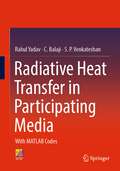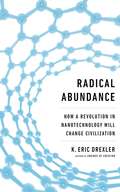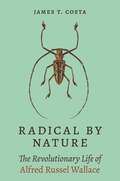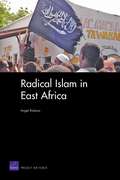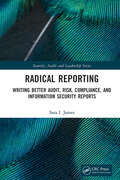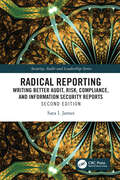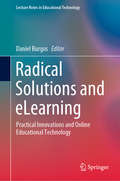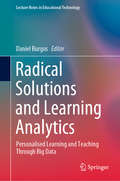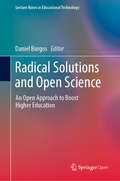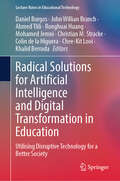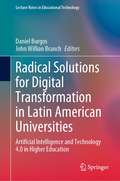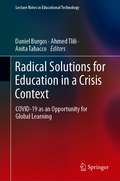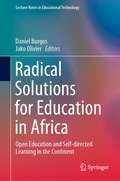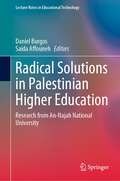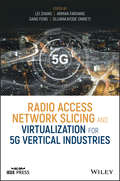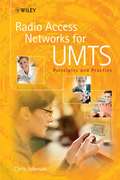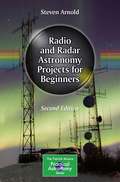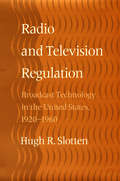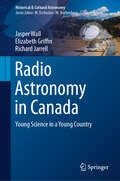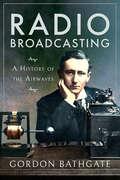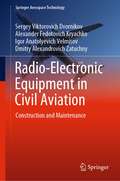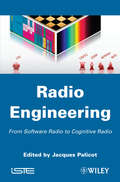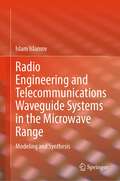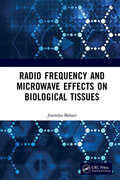- Table View
- List View
Radiative Heat Transfer in Participating Media: With MATLAB Codes
by Rahul Yadav C. Balaji S. P. VenkateshanThis book aims at providing a computational framework of radiative heat transfer in participating media. The book mainly helps engineers and researchers develop their own codes for radiative transfer analysis, starting from simple benchmark problems and extending further to industry scale problems. The computations related to radiative heat transfer are very relevant in iron and steel manufacturing industries, rocket exhaust designing, fire resistance testing, and atmospheric and solar applications. The methods to accurately treat the non-gray nature of the participating gases such as H2O, CO2, and CO are discussed along with considering particle radiation. The solver development based on these methods and its application to a variety of industry problems and different kind of geometries is a significant attraction in the book. The last section of the book deals with the use of artificial neural networks and genetic algorithm-based optimization technique for solving practical problems of process parameter optimization in industry. This book is a comprehensive package taking the readers from the basics of radiative heat transfer in participating media to equip them with their own solvers and help to apply to industry problems.
Radical Abundance: How a Revolution in Nanotechnology Will Change Civilization
by K. Eric DrexlerK. Eric Drexler is the founding father of nanotechnology-the science of engineering on a molecular level. In Radical Abundance, he shows how rapid scientific progress is about to change our world. Thanks to atomically precise manufacturing, we will soon have the power to produce radically more of what people want, and at a lower cost. The result will shake the very foundations of our economy and environment. Already, scientists have constructed prototypes for circuit boards built of millions of precisely arranged atoms. The advent of this kind of atomic precision promises to change the way we make things-cleanly, inexpensively, and on a global scale. It allows us to imagine a world where solar arrays cost no more than cardboard and aluminum foil, and laptops cost about the same. A provocative tour of cutting edge science and its implications by the field’s founder and master, Radical Abundance offers a mind-expanding vision of a world hurtling toward an unexpected future.
Radical by Nature: The Revolutionary Life of Alfred Russel Wallace
by James T. CostaA major biography of the brilliant naturalist, traveler, humanitarian, and codiscoverer of natural selectionAlfred Russel Wallace (1823–1913) was perhaps the most famed naturalist of the Victorian age. His expeditions to remote Amazonia and southeast Asia were the stuff of legend. A collector of thousands of species new to science, he shared in the discovery of natural selection and founded the discipline of evolutionary biogeography.Radical by Nature tells the story of Wallace&’s epic life and achievements, from his stellar rise from humble origins to his complicated friendship with Charles Darwin and other leading scientific lights of Britain to his devotion to social causes and movements that threatened to alienate him from scientific society.James Costa draws on letters, notebooks, and journals to provide a multifaceted account of a revolutionary life in science as well as Wallace&’s family life. He shows how the self-taught Wallace doggedly pursued bold, even radical ideas that caused a seismic shift in the natural sciences, and how he also courted controversy with nonscientific pursuits such as spiritualism and socialism. Costa describes Wallace&’s courageous social advocacy of women&’s rights, labor reform, and other important issues. He also sheds light on Wallace&’s complex relationship with Darwin, describing how Wallace graciously applauded his friend and rival, becoming one of his most ardent defenders.Weaving a revelatory narrative with the latest scholarship, Radical by Nature paints a mesmerizing portrait of a multifaceted thinker driven by a singular passion for science, a commitment to social justice, and a lifelong sense of wonder.
Radical Human Ecology: Intercultural and Indigenous Approaches
by Rose RobertsHuman ecology - the study and practice of relationships between the natural and the social environment - has gained prominence as scholars seek more effectively to engage with pressing global concerns. In the past seventy years most human ecology has skirted the fringes of geography, sociology and biology. This volume pioneers radical new directions. In particular, it explores the power of indigenous and traditional peoples' epistemologies both to critique and to complement insights from modernity and postmodernity. Aimed at an international readership, its contributors show that an inter-cultural and transdisciplinary approach is required. The demands of our era require a scholarship of ontological depth: an approach that can not just debate issues, but also address questions of practice and meaning. Organized into three sections - Head, Heart and Hand - this volume covers the following key research areas: Theories of Human Ecology Indigenous and Wisdom Traditions Eco-spiritual Epistemologies and Ontology Research practice in Human Ecology The researcher-researched relationship Research priorities for a holistic world With the study of human ecology becoming increasingly imperative, this comprehensive volume will be a valuable addition for classroom use.
Radical Islam in East Africa
by Angel RabasaAmerican geopolitical interests and the potential threats to those interests are both on the rise in East Africa. The author places the spread of militant Islamism and the development of radical Islamist networks in East Africa in the broader context of the social, economic, and political factors that have shaped the region's security environment.
Radical Reporting: Writing Better Audit, Risk, Compliance, and Information Security Reports (Security, Audit and Leadership Series)
by Sara I. JamesMost people dread writing reports; they also dread reading reports. What they don’t realize is that the techniques that make writing more readable make it more powerful. This is especially relevant for professionals in areas such as audit, risk, compliance, and information security. This small volume provides the tools and techniques needed to improve reports. It does so through addressing crucial concepts all too often overlooked in the familiar rush to perform tasks, complete projects, and meet deadlines. These concepts – the role of culture in communication; the link between logic and language; the importance of organizing thoughts before writing; and how to achieve clarity – may seem academic or theoretical. They’re not. Unless writers understand their own thoughts, actions, and objectives, they cannot hope to communicate them at all – let alone clearly.
Radical Reporting: Writing Better Audit, Risk, Compliance, and Information Security Reports (Security, Audit and Leadership Series)
by Sara I. James"If I were giving out an award for 'book of the year' for internal audit professionals, I would certainly award it to her outstanding manuscript: Radical Reporting: Writing Better Audit, Risk, Compliance and Information Security Reports." - Richard Chambers, Former President and CEO, The Institute of Internal AuditorsMost people dread writing reports; they also dread reading reports. What they don’t realize is that the techniques that make writing more readable make it more powerful. This is especially relevant for professionals in areas such as audit, risk, compliance, and information security.This small volume provides the tools and techniques needed to improve reports. It does so through addressing crucial concepts all too often overlooked in the familiar rush to perform tasks, complete projects, and meet deadlines.These concepts – the role of culture in communication; the link between logic and language; the importance of organizing thoughts before writing; and how to achieve clarity – may seem academic or theoretical. They’re not. Unless writers understand their own thoughts, actions, and objectives, they cannot hope to communicate them at all – let alone clearly.This second edition develops these points with additional material on critical thinking, as well as the use of AI in reporting.
Radical Solutions and eLearning: Practical Innovations and Online Educational Technology (Lecture Notes in Educational Technology)
by Daniel BurgosEducational Technology is the right couple to a radical innovation. Thanks to the appropriate technology in the right context with the best fit to the target audience, education can be drastically improved, meaning a better performance, competence achievement, match with the user’s expectations and with the market needs. Serious games, Virtual reality, Augmented reality, Remote labs, Online learning, Blockchain, Mobile learning and many other key technologies allow for a better explanation of so many subjects, and even more: for a complete student involvement and a full teacher engagement into the educational system. Technology gives another angle to the same content, provides the user with a personalised experience and pushes the limits of knowledge a little further, every time. This book presents a number of radical innovations through technology, from experienced cases studies, to be replicated and inspired by; a powerful resource handbook for cutting-edge education.
Radical Solutions and Learning Analytics: Personalised Learning and Teaching Through Big Data (Lecture Notes in Educational Technology)
by Daniel BurgosLearning Analytics become the key for Personalised Learning and Teaching thanks to the storage, categorisation and smart retrieval of Big Data. Thousands of user data can be tracked online via Learning Management Systems, instant messaging channels, social networks and other ways of communication. Always with the explicit authorisation from the end user, being a student, a teacher, a manager or a persona in a different role, an instructional designer can design a way to produce a practical dashboard that helps him improve that very user’s performance, interaction, motivation or just grading. This book provides a thorough approach on how education, as such, from teaching to learning through management, is improved by a smart analysis of available data, making visible and useful behaviours, predictions and patterns that are hinder to the regular eye without the process of massive data.
Radical Solutions and Open Science: An Open Approach to Boost Higher Education (Lecture Notes in Educational Technology)
by Daniel BurgosThis open access book presents how Open Science is a powerful tool to boost Higher Education. The book introduces the reader into Open Access, Open Technology, Open Data, Open Research results, Open Licensing, Open Accreditation, Open Certification, Open Policy and, of course, Open Educational Resources. It brings all these key topics from major players in the field; experts that present the current state of the art and the forthcoming steps towards a useful and effective implementation. This book presents radical, transgenic solutions for recurrent and long-standing problems in Higher Education. Every chapter presents a clear view and a related solution to make Higher Education progress and implement tools and strategies to improve the user’s performance and learning experience. This book is part of a trilogy with companion volumes on Radical Solutions & Learning Analytics and Radical Solutions & eLearning.
Radical Solutions for Artificial Intelligence and Digital Transformation in Education: Utilising Disruptive Technology for a Better Society (Lecture Notes in Educational Technology)
by Daniel Burgos John Willian Branch Ahmed Tlili Ronghuai Huang Mohamed Jemni Christian M. Stracke Colin de la Higuera Chee-Kit Looi Khalid BerradaThis book facilitates understanding of how artificial intelligence (AI) aids and integrates digital transformation (DT) in education institutions worldwide in various scenarios: learning environments (learning innovation, learning management systems, data and analytics), emerging education trends (business trends, strategic technologies), administrative systems (recruit, retain, advance, enterprise business capabilities, student information systems), and digital strategy execution (business models and opportunities, strategic planning and governance). It serves as a reference for university lecturers, schoolteachers, policymakers, and international organizations, who will find in its various chapters practical recommendations and discoveries from practice, ready to be implemented in their contexts. Chapters 1, 2, 7 and 9 are available open access under a Creative Commons Attribution 4.0 International License via link.springer.com.
Radical Solutions for Digital Transformation in Latin American Universities: Artificial Intelligence and Technology 4.0 in Higher Education (Lecture Notes in Educational Technology)
by Daniel Burgos John Willian BranchThis book presents how Digital Transformation is a requirement to upgrade Latin American universities to a next level in management, lecturing and learning processes and strategies. The book starts with a thorough introduction of the Latin American context addressing the three main topics in the book: Digital Transformation, Higher Education and Artificial Intelligence & Industry 4.0. They will be depicted by region, with a clear distribution between Central America & Mexico, Comunidad Andina (Perú, Colombia, Chile, Ecuador, Bolivia), Mercosur (Argentina, Brasil, Paraguay and Uruguay), and other countries. The book also shows how online learning is a key part of the transformation, with a clear focus on learning management systems, innovation and learning analytics. Further, personalised services for every single profile at the university (students, lecturers, academic managers) are presented to guarantee inclusive education service aggregation for networked campuses. Following, the book addresses strategy and overall services that concentrate on sustainability and revenue models integrated with a strategic planning. Finally a set of chapters will show specific experiences and case studies of direct application of Artificial Intelligence and Technology 4.0, where the readers can learn from and transfer directly into their educational contexts.
Radical Solutions for Education in a Crisis Context: COVID-19 as an Opportunity for Global Learning (Lecture Notes in Educational Technology)
by Daniel Burgos Ahmed Tlili Anita TabaccoThis book presents how to keep working on education in contexts of crisis, such as emergencies, zones of conflict, wars and health pandemics such as COVID-19. Specifically, this work shows a number of strategies to support global learning and teaching in online settings. Particularly, it first presents how to facilitate knowledge sharing and raising awareness about a specific crisis, to increase people’s safety, including educators and learners. The book then discusses various techniques, mechanisms and services that could be implemented to provide effective learning support for learners, especially in learning environments that they do not daily use, such as physical classrooms. Further, the work presents how to teach and support online educators, no matter if they are school teachers, university lecturers, youth social workers, vocational training facilitators or of any other kind. Finally, it describes worldwide case studies that have applied practical steps to keep education running during a crisis.This book provides readers with insights and guidelines on how to maintain learning undisrupted during contexts of crisis. It also provides basic and practical recommendations to the various stakeholders in educational contexts (students, content providers, technology services, policy makers, school teachers, university lecturers, academic managers, and others) about flexible, personalised and effective education in the context of crisis.
Radical Solutions for Education in Africa: Open Education and Self-directed Learning in the Continent (Lecture Notes in Educational Technology)
by Daniel Burgos Jako OlivierThis book explores the state of open education in terms of self-directed learning on the African continent. Through a combination of conceptual, systematic literature review and empirical chapters, readers will get a research-based impression of these aspects in this area. Apart from presenting existing wider trends regarding open education, this book also reports on effective open practices in support of self-directed learning.
Radical Solutions in Palestinian Higher Education: Research from An-Najah National University (Lecture Notes in Educational Technology)
by Daniel Burgos Saida AffounehThis book brings together education research and practice carried out by An-Najah National University, a lead Higher Institution in Palestine that managed to move from a face-to-face setting to a fully online learning and teaching environment during the initial COVID-19 outbreak, within a month, seamlessly, which makes a success cases study of virtualization. This book concentrates on approaches to ensure the continuous improvement and quality of higher education provision across the country, with particular focus on: a) learning and teaching methodologies in online settings; b) use of open education as a key resource; and c) development of academic capability building, along with academic and knowledge exchange with other higher education partners. Innovative ideas, best practices, and comparative case studies are presented, discussed, and compared with international ones to make specific recommendations for a successful and sustainable implementation.
Radio Access Network Slicing and Virtualization for 5G Vertical Industries (Wiley - IEEE)
by Lei ZhangLearn how radio access network (RAN) slicing allows 5G networks to adapt to a wide range of environments in this masterful resource Radio Access Network Slicing and Virtualization for 5G Vertical Industries provides readers with a comprehensive and authoritative examination of crucial topics in the field of radio access network (RAN) slicing. Learn from renowned experts as they detail how this technology supports and applies to various industrial sectors, including manufacturing, entertainment, public safety, public transport, healthcare, financial services, automotive, and energy utilities. Radio Access Network Slicing and Virtualization for 5G Vertical Industries explains how future wireless communication systems must be built to handle high degrees of heterogeneity, including different types of applications, device classes, physical environments, mobility levels, and carrier frequencies. The authors describe how RAN slicing can be utilized to adapt 5G technologies to such wide-ranging circumstances. The book covers a wide range of topics necessary to understand RAN slicing, including: Physical waveforms design Multiple service signals coexistence RAN slicing and virtualization Applications to 5G vertical industries in a variety of environments This book is perfect for telecom engineers and industry actors who wish to identify realistic and cost-effective concepts to support specific 5G verticals. It also belongs on the bookshelves of researchers, professors, doctoral, and postgraduate students who want to identify open issues and conduct further research.
Radio Access Networks for UMTS
by Chris JohnsonThis book provides a comprehensive description of Radio Access Networks for UMTS . The main content is based upon the release 6 version of the 3GPP specifications. Changes since the release 99 version are described while some of the new features from the release 7 version are introduced.Starting from the high-level network architecture, the first sections describe the flow of data between the network and end-user. This includes a dedicated chapter describing the Iub transport network. Detailed descriptions of both HSDPA and HSUPA reflect the increasing importance of efficient high data rate connections. Signalling procedures are described for speech, video and PS data connection establishment, SMS data transfer, soft handover and inter-system handover. The more practical subjects of link budgets and radio network planning are also addressed.More than 180 example log files reinforce the reader's understandingSummary bullet points allow rapid access to the most important informationFocus upon how data is transferred between the network and end-userDedicated chapters provide detailed descriptions of both HSDPA and HSUPAStep-by-step analysis of common signalling proceduresKey radio network planning subjects addressedRadio Access Networks for UMTS is ideal for mobile telecommunications engineers working for equipment vendors, operators and regulators. It will also appeal to system designers, technical managers and students.
Radio and Radar Astronomy Projects for Beginners (The Patrick Moore Practical Astronomy Series)
by Steven ArnoldRadio and radar astronomy are powerful tools when studying the wonders of the universe, yet they tend to mystify amateur astronomers. This book provides a comprehensive introduction to newcomers, containing everything you need to start observing at radio wavelengths.Written by a mechanical engineer who has actually built and operated the tools described, the book contains a plethora of tested advice and practical resources. This revised edition of the original 2014 book Getting Started in Radio Astronomy provides a complete overview of the latest technology and research, including the newest models and equipment on the market as well as an entirely new section on radio astronomy with software-defined radios (SDRs). Four brand-new beginner projects are included, including bouncing a radar signal off the Moon, detecting the aurora, and tuning into the downlink radio used by astronauts aboard the ISS. Requiring no previous knowledge, no scary mathematics, and no expensive equipment, the book will serve as a fun and digestible reference for any level of astronomers hoping to expand their skills into the radio spectrum.
Radio and Television Regulation: Broadcast Technology in the United States, 1920-1960
by Hugh R. SlottenFrom AM radio to color television, broadcasting raised enormous practical and policy problems in the United States, especially in relation to the federal government's role in licensing and regulation. How did technological change, corporate interest, and political pressures bring about the world that station owners work within today (and that tuned-in consumers make profitable)? In Radio and Television Regulation, Hugh R. Slotten examines the choices that confronted federal agencies—first the Department of Commerce, then the Federal Radio Commission in 1927, and seven years later the Federal Communications Commission—and shows the impact of their decisions on developing technologies.Slotten analyzes the policy debates that emerged when the public implications of AM and FM radio and black-and-white and color television first became apparent. His discussion of the early years of radio examines powerful personalities—including navy secretary Josephus Daniels and commerce secretary Herbert Hoover—who maneuvered for government control of "the wireless." He then considers fierce competition among companies such as Westinghouse, GE, and RCA, which quickly grasped the commercial promise of radio and later of television and struggled for technological edge and market advantage. Analyzing the complex interplay of the factors forming public policy for radio and television broadcasting, and taking into account the ideological traditions that framed these controversies, Slotten sheds light on the rise of the regulatory state. In an epilogue he discusses his findings in terms of contemporary debates over high-resolution TV.
Radio Astronomy in Canada: Young Science in a Young Country (Historical & Cultural Astronomy)
by Jasper Wall Elizabeth Griffin Richard JarrellHere is the tale of Canada’s intriguing development of the science of Radio Astronomy. In 1946 the lone figure of Arthur Covington started monitoring the radio emission of the Sun, a programme that continues to this day. By the 1960s Canada had progressed to constructing two radio observatories at either ends of the country (the DRAO and the ARO), and universities were coming onboard. The story continues through the dire times for these and follows their fortunes and fates right up to the present, with Canada now playing key roles in billion-dollar international telescope projects. It concludes with the construction and operation of Canada’s own transformational telescope, CHIME. Anecdotes and images throughout the book liven the story.The authors—two practising astronomers—have painstakingly put together this fascinating story, drawing on first-hand experiences, valuable contributions from many colleagues, and the research of science historian, Richard Jarrell (1942-2013).This book fills a gap in the substantial literature on the history of radio astronomy. Carefully-researched by three experts and based on input by further experts in the field, it documents the extensive scientific and (especially) technical innovations of Canadian scientists and engineers. This includes the important Canadian absolute flux-density calibrations, the critical Canadian contribution to low-frequency radio astronomy and VLBI, and the long-running solar monitoring programme. Frank discussions about the excellent 46-m ARO telescope and its fate lead into considerations of Canada’s contributions to recent international projects – the JCMT, ALMA and the upcoming SKA. The book concludes with a description of CHIME, Canada’s own new-generation radio installation.Ken Kellermann, Senior Scientist Emeritus, National Radio Astronomy Observatory, Charlottesville, USA
Radio Broadcasting: A History of the Airwaves
by Gordon BathgateAn in-depth look at a century of radio history—and its continuing relevance in a radically changed world.A century after Marconi’s experimental transmissions, this book examines the history of radio and traces its development from theories advanced by James Clerk Maxwell and Heinrich Hertz to the first practical demonstrations by Guglielmo Marconi. It looks back to the pioneering broadcasts of the BBC, examines the development of broadcast networks in North America and around the world, and spotlights radio’s role in the Second World War.The book also features the radio programs and radio personalities that made a considerable impact on listeners during the “Golden Era.” It examines how radio, faced by competition from television, adapted and survived. Indeed, radio has continued to thrive despite increased competition from mobile phones, computers, and other technological developments. Radio Broadcasting looks ahead and speculates on how radio will fare in a multi-platform future.
Radio-Electronic Equipment in Civil Aviation: Construction and Maintenance (Springer Aerospace Technology)
by Sergey Viktorovich Dvornikov Alexander Fedotovich Kryachko Igor Anatolyevich Velmisov Dmitry Alexandrovich ZatuchnyThis book presents the maintenance of radio equipment and the principles of operation of various radio receiving devices in civil aviation. The main feature of this book is the fact that it covers almost all types of radio receivers currently used in radar, communication and navigation equipment of civil aviation. Special attention is paid to ensuring the sensitivity of the receiver, as well as noise suppression under various conditions. A detailed description of the set of methods for receiving signals, especially in the case of frequency telegraphy is presented. This book provides a detailed description of specific methods of signal processing with frequency modulation—the so-called threshold-lowering reception methods based on reducing the bandwidth to the detector part of the private reception path in combination with the principle of negative feedback. The material presented in this book follows a logical sequence with a large amount of illustrations.
Radio Engineering: From Software Radio to Cognitive Radio (Lecture Notes Of The Institute For Computer Sciences, Social Informatics And Telecommunications Engineering Ser. #172)
by Jacques Palicot Pierre‐Noël FavennecSoftware radio ideally provides the opportunity to communicate with any radio communication standard by modifying only the software, without any modification to hardware components. However, taking into account the static behavior of current communications protocols, the spectrum efficiency optimization, and flexibility, the radio domain has become an important factor. From this thinking appeared the cognitive radio paradigm. This evolution is today inescapable in the modern radio communication world. It provides an autonomous behavior to the equipment and therefore the adaptation of communication parameters to better match their needs. This collective work provides engineers, researchers and radio designers with the necessary information from mathematical analysis and hardware architectures to design methodology and tools, running platforms and standardization in order to understand this new cognitive radio domain.
Radio Engineering and Telecommunications Waveguide Systems in the Microwave Range: Modeling and Synthesis
by Islam IslamovThe book systematizes numerical methods for modelling and synthesizing radio engineering and telecommunication systems in the microwave range of rectangular and circular waveguides. The author gives the theoretical foundations for the analysis and optimal synthesis of these systems and presents the results of new research. The book uses the HFSS complex to analyse, optimize, and synthesize microwave systems operating on E-type and H-type waves while providing the outcomes. As a result of analysis and synthesis, various microwave devices with improved technical and operational parameters have been developed, and on their basis a new system of waveguide paths is proposed that connects the transmitter and antenna in TV towers. The book is intended for engineers and scientists involved in the design of radio engineering and telecommunication systems.
Radio Frequency and Microwave Effects on Biological Tissues
by Jitendra BehariFocussing on engineering aspects of RF/Microwave interaction with biological tissues This book discusses the advancement in bio-electromagnetics pertaining to this important issue of electromagentic field-bio interaction vis-a-vis the emission of electromagnetic radiations from mobile phones and their biological fallout. Divided into six chapters, it discusses basic issues in Electromagnetic Field-Biointeraction, dosimetery, instrumentation, and methods of measurement of specific absorption rate, criteria and magnitude of safe exposure and measurements of field in an open (unobstructed) environment.
